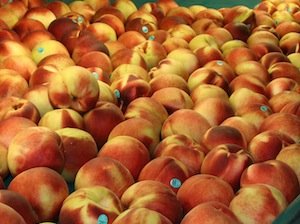Supplies of peaches, plums, nectarines, and apricots will be short, but cherries and pears should be closer to normal.
As damage reports from major hailstorms that swept through California in mid-April are being finalized, unofficially, the state’s peach, plum, nectarine, and apricot crops are estimated at 40 million boxes, a number off by 5 to 10 million, says the leader of a statewide trade association of tree fruit growers and shippers. However, cherries and pears should fare much better.
“Obviously, our stone fruit growers had material impact from the hail,” said Barry Bedwell, president of the California Grape and Tree Fruit League, representing the state’s tree fruit and grape industries. “The 40 million number is a very unofficial estimate of a crop number that could go further south,” he said, noting that in the last decade, shipping volume numbers have been in the 45 to 50 million-box range, with 60 million boxes shipped in the early 2000s. “Supplies this year will be adequate but tight.”
Since the California Tree Fruit Agreement, which administered the federal marketing orders for California’s peaches and nectarines, closed its doors in 2011 after growers voted down the marketing orders, the industry has no entity collecting crop, shipment, and market data. The Grape and Tree Fruit League, although a voluntary organization, has stepped in to assist the industry where it can, and is gearing up to implement a limited export program for stone fruit growers.
Tulare County, which is the heart of stone fruit production in California, was also at the center of the hailstorm’s path, a swath said to have covered 75 square miles. Final crop damage numbers are still coming in, but Tulare county agricultural officials believe the number will be higher than 20 percent. “On an individual basis, the range of damage is from 10 to 100 percent,” said Gavin Iacono of the Tulare County agricultural commissioner’s office. Official numbers are needed before federal disaster declarations can be made.
Kings County, adjacent to Tulare but with fewer stone fruit growers, reported a 30.3 percent loss in apricots, cherries, and nectarines and a 33.4 percent loss in peaches and plums. For Kings County growers, the total estimated value of damage and lost yields is nearly $20.5 million.
Impacts from the weather will be felt in many areas, including fewer shippers participating in the state’s stone fruit export program to Mexico. Iacono said that already a major shipper has pulled out of the export program, and several others will have reduced amounts available for export. After Canada, Mexico is the largest export market for California’s stone fruit.
Cherries, pears
Cherry harvest is in its second week in the early district of southern San Joaquin Valley, although the crop there is said to be running light due to erratic bloom, cold temperatures during bloom, and some thinning from hail storms. Harvest in the central portion of the valley near Stockton and Lodi is expected to begin mid-May with Coral Champagne leading the harvest, followed by Bing near Memorial Day, says Chris Zanobini, manager of the California Cherry Marketing and Research Board. Both Coral Champagne and Bing varieties look to have good crops, he said, adding that the official crop forecast is for a normal crop of around 8 million boxes, bearing further impact from weather. Last year’s crop was around 6 million boxes, far less than originally predicted due to rain late in the season.
For pears, it’s too early to tell, said Zanobini, who also serves as manager of the California Pear Advisory Board. Official crop estimates won’t be made until the first week of June, but he said that the crop thus far appears to be good—though not a limb breaker. Conditions for bloom were good in Lake County and bloom was tight, which should help avoid wide gaps in harvest.


Leave A Comment